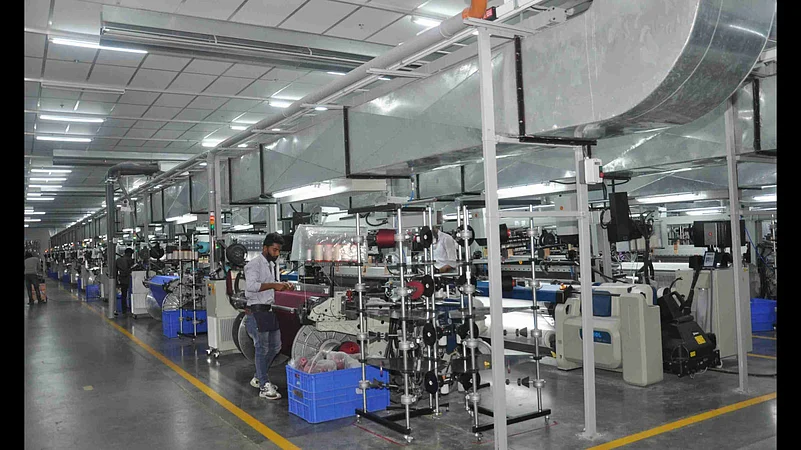The textiles sector is one of the oldest and most prominent industries in the Indian subcontinent. It is the second-largest employer in India, offering direct and indirect employment to approximately 45 million people across the country. The textile industry was responsible for around 7% of the industrial output in 2018-19, in addition to contributing 2% to the country’s GDP and 12% to its export earnings during the same period.
Showing remarkable resilience, India’s home textile exports clocked a robust growth rate of 9% in FY21 during – and despite – the pandemic. The country exported textiles worth INR 1.77 lakh crore between January and July 2021, surpassing even pre-pandemic levels by 13.7%. On the other hand, India’s technical textiles industry is projected to swell to USD 23.3 billion by 2027.
Advertisement
Maharashtra comprises a significant chapter in the remarkable growth story of India as a textiles powerhouse. In turn, the textiles sector plays a crucial role in the state’s economy, being the second-largest employment enabler in Maharashtra, after agriculture. Boasting a world-class infrastructure for procurement, storage and processing, the state accounts for 25% (65 million kgs) of the country’s total cotton production. Maharashtra also accounts for 10.4% of the country’s total textile and apparel production and 10.2% of the total employment in the textile sector. Additionally, the state produces 272 million kilogrammes of yarn, which is 12% of India’s gross production. In terms of production tools, Maharashtra features a capacity for 1.66 million spindles, 17% of the national total.
Advertisement
The role of policy support in making Maharashtra the textile titan of India
Buoyed by the easy availability of raw materials, skilled manpower, and lower production costs, Maharashtra has emerged as the key stakeholder and growth driver of the country’s textile industry. The state not only boasts of the largest area under cultivation for cotton but is also home to the largest number of skilled workers in the country. Metropolises such as Mumbai and other textile clusters have emerged as major export hubs, equipped with the infrastructure and skills to easily meet the increasing demand for silk, silk products, wool, cotton, and non-conventional yarn. The climatic, demographic, and geographic advantage enjoyed by the region is further enhanced by the state’s sound policy mechanism.
The state’s Textile Policy 2011-17 is credited with making the concept of fibre to fashion a reality, attracting investments worth INR 20 crore and generating 3 lakh new employment opportunities. In a push towards boosting the textile ecosystem, Maharashtra revamped the previous policy with a future-forward vision. The new, more ambitious textile policy 2018-23 aims to employ 10 lakh new workers in the next 5 years and bring investments to the tune of INR 36,000 crore.
Besides strengthening the production of cotton, silk, and wool, as well as the knitting, hosiery, and garmenting sector, the policy will also promote non-conventional yarn production. It also prioritises skill development and research for the revival and sustenance of the textile industry in the state while focusing on promoting the usage of green energy and sustainable manufacturing techniques. Emphasis will also be laid on filling the void between the theoretical and practical aspects of textile education through the establishment of a first-of-its-kind textile-focused university dedicated to innovation and research, as well as the development of projects in agriculture universities.
Advertisement
The policy also aims to provide benefits such as power tariffs and capital subsidies for minority categories. Women, who comprise the oft-ignored but crucial stakeholders of the textile industry, will receive benefits through programs dedicated to developing and supporting women entrepreneurs. The textile department has also proposed plans to set up a Textile Development Fund to counteract hassles in funding while meeting essential infrastructure needs of the textile industry. The fund will spring from government equities, the sale of lands belonging to the textile department, and CSR funds from textile enterprises availing government schemes and subsidies. The scheme is complemented by the formation of a vigilance and controlling committee to verify textile projects.
Advertisement
All of these measures are aimed at making the state’s textile industry more comprehensive and inclusive with the ability to not just compete with but also lead in international markets.
The perfect investment destination
The state holds great potential to produce goods for foreign markets, especially in value-added segments such as garments and fashion products. Investments have also been made in the form of textile parks being set up in Nagpur, Dhule, Ambernath, Amravati, etc., to enhance production output and drive textile making and exports. The major stakeholders in the state include Bombay Dyeing, Century Textiles, Raymond, etc. Raymond has increased its denim manufacturing capacity in the state by 10 million metres per annum to 30 million metres per annum through a USD 28 million investment at its Yavatmal plant. Carrera Holding Inc. plans to pump USD 130 million into the Kolhapur region to set up a one-of-a-kind textile project in the country.
Advertisement
Amravati, in particular, has emerged as a key textile cluster and a focal point for the realisation of the state's goals. It is the administrative headquarter of Amravati Division in the Vidarbha Region containing 14 talukas and 8 Vidhan Sabha constituencies. It boasts of major infrastructure facilities such as roads, electricity, and water supply and features 24 textile parks being developed by major textile units. The state government is set to offer plug-and-play infrastructure in new industrial land bank spanning 4,000 acres across Amravati and Nagpur as a part of Magnetic Maharashtra 2.0 Initiatives launched by the state. Special priority will be given to providing irrigation facilities and setting up cotton processing units in these areas.
Advertisement
Maharashtra has enjoyed a long and fruitful association with the textiles sector, serving as an incubation and business ground for the textile culture and industries. The new schemes and policies introduced by the government further bolster the state’s position as a major textile hub of India. Innovations and ideas require fertile locations to set roots in as well as open-minded care to bear fruits. The natural advantages combined with forward-looking regulatory support make Maharashtra precisely the location that offers ideal conditions for players in the textile industry to flourish.















 Just one email a week
Just one email a week